Monetize my product using usage-based pricing
Dive deep into the different usage based pricing models to find the option that best suits your needs
Overview
Usage-based pricing models have gained traction in recent years, driven by customer demand to pay according to their actual usage or consumption of a product. This approach allows customers to begin with minimal costs, making it more enticing for them to start using the product, while also providing vendors with valuable insights into usage patterns.
However, this is not merely a pay and use method. It has evolved into a wide range of models supporting diverse use cases and creating new opportunities for expansion.
Usage based pricing model can be implemented in one of the following ways:
- In-advance commitment - The customer gets to choose at which cost they’d like to start and keep this pricing for the determined period of time.
- Pay-as-you-go - The customer can start at no cost, and purchase feature units upon request.
Here’s a description of the different pricing models offered on Stigg:
Flat rate
What is it?
A single fixed price for each unit per selected billing period (month/year). It's ideal for billing features or services with relatively stable delivery costs that do not vary significantly based on specific customer requirements.
Example
Seats / users on an account, for example each seat costs $10/month, so 2 seats will cost $20/month and so on.
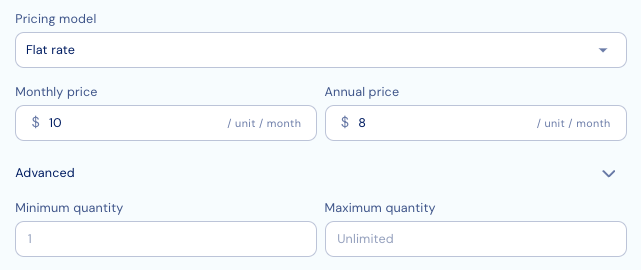
Implementation in Stigg
Learn more on how the flat rate pricing model can be implemented in Stigg.
Package pricing
What is it?
Package pricing allows you to charge a set price per block of units. In this model, customers pay a fixed amount for each defined block of usage, regardless of whether they use the entire block.
This model offers predictable costs and simplifies billing for both customers and businesses.
Example
I want to buy 80 templates. According to the below table, I'll need to buy 2 packages of 50 templates and will be charged $40.
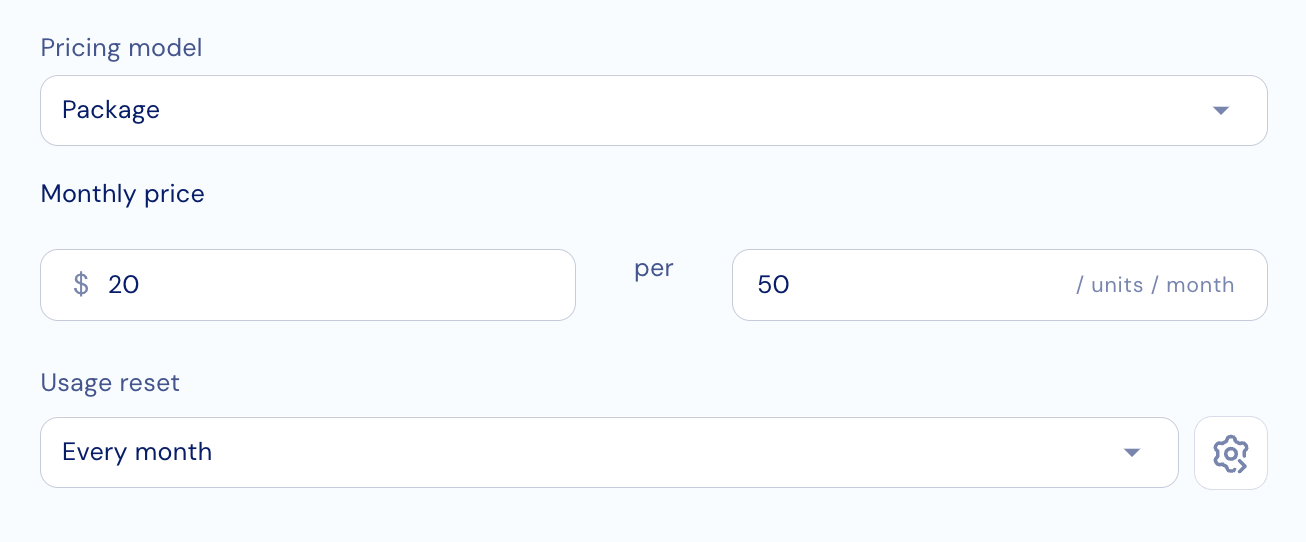
Implementation in Stigg
Learn more about how the volume pricing model can be implemented in Stigg.
Tiered pricing
What is it?
A progressive model where the unit price changes based on the “tier” it falls into. As the number of units purchased increases and moves into higher ranges, discounts increase, resulting in customers paying less per unit.
This structure encourages customers to purchase more to achieve a lower price per unit, potentially boosting overall sales volumes.
Example
I want to buy 25 templates. According to the below table, it falls under the 21-unlimited tier, hence I’ll pay $105
Cost breakdown:
First 10 template cost $5/each
Next 10 templates cost $4/each
Next 5 templates cost $3/each
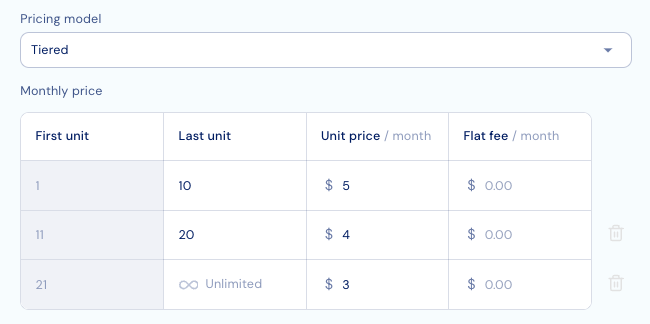
Implementation in Stigg
Learn more on how the tiered pricing model can be implemented in Stigg.
Volume pricing
What is it?
In this model, the per-unit cost decreases as the quantity purchased increases. Each unit range has a set price, and once the number of units reaches a certain threshold, all units are priced at the new, lower rate. This incentivizes customers to buy in larger quantities, thereby increasing sales volumes and overall profitability.
Example
I want to buy 25 templates. According to the below table, 25 templates will be priced at $3/unit, hence 25x$3=$75
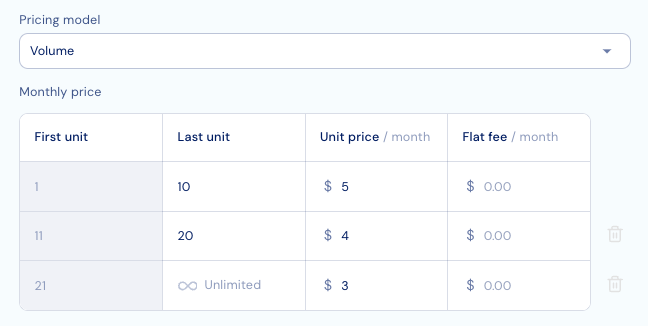
Implementation in Stigg
Learn more about how the volume pricing model can be implemented in Stigg.
Stair-step pricing
What is it?
Stair-step pricing involves a flat rate for defined ranges of quantities, creating distinct pricing "steps." Each step represents a volume tier, with the price remaining constant within that tier, regardless of the exact quantity purchased. This pricing model drives customers to purchase units in bulks, rather than purchasing them one-by-one.
Example
I want to buy 25 templates. 25 falls in the second quantity range, so I’ll pay $60. As simple as that.
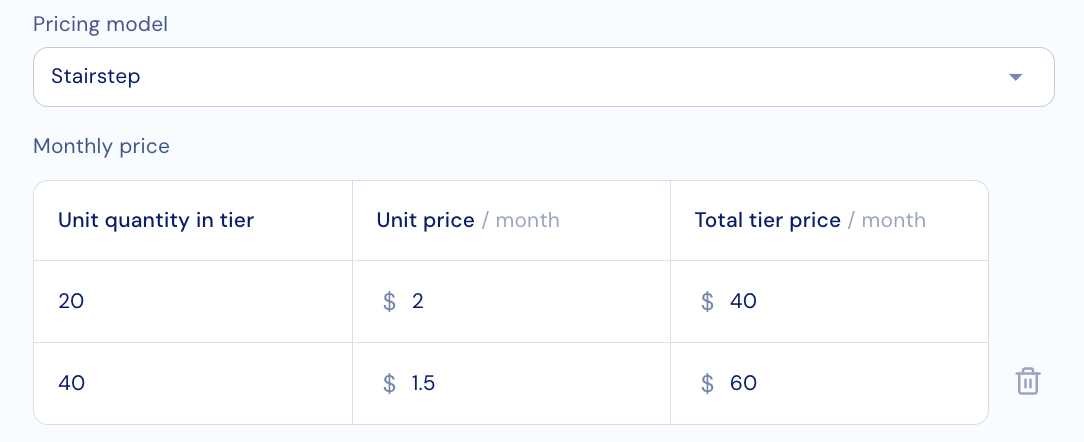
Implementation in Stigg
Learn more about how the stair-step pricing model can be implemented in Stigg.
Hybrid pricing
What is it?
Hybrid pricing is a pricing model that combines base charge and usage based pricing, giving business the flexibility of charging customers a subscription fee in addition to fees that are based on their usage of a product or a service. This approach offers both vendors and customers a good balance between predictability and flexibility: Vendors can benefit from a recurring and predictable revenue alongside flexibility around their offerings to cater to the needs of different customers and increase revenue. Customers get an agreed-upon fixed price while having the ability to control their spend through usage.
Example:
I want to buy an access to the app, and also allow 15 of my users to use it:
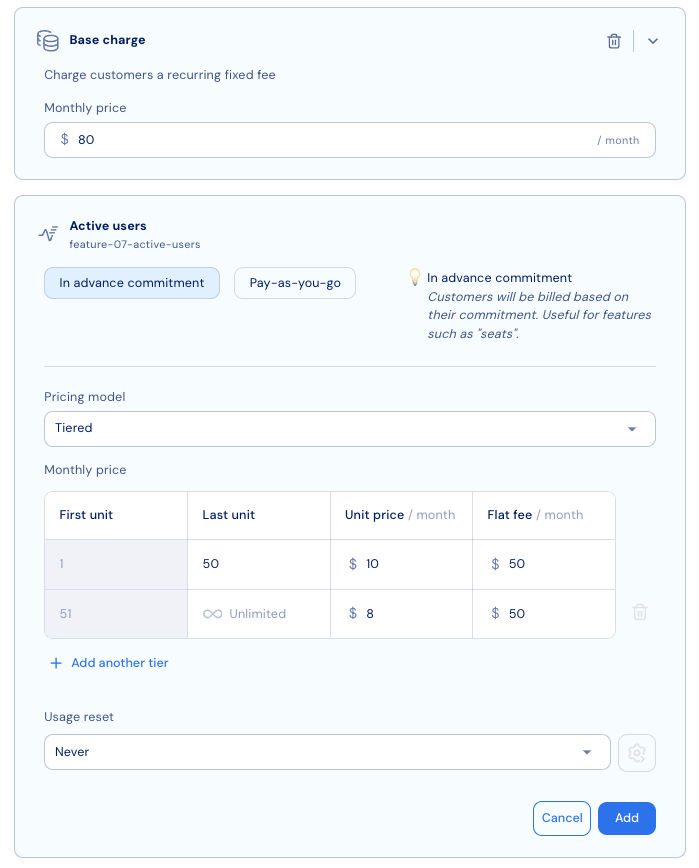
Implementation in Stigg
Learn here how to set up a base charge in Stigg and learn here how to set up a usage based charge in Stigg.
Reference
Key considerations
- Ensure that pricing for each tier/unit is set for both monthly and annual billing periods if both options are available.
- Offering discounted pricing on higher quantity tiers is recommended to incentivize customers to purchase more.
The bottom line
Usage-based pricing models offer flexibility and transparency for both customers and vendors, allowing for more tailored pricing structures based on actual usage.
The best pricing strategy for your business depends on the type of product you’re selling, what your customers are willing to pay, and what value your product offers. This strategy can involve using a single pricing model or combining multiple models, allowing you to tailor pricing to different features or usage levels.
Furthermore, remember that this is not a set-it-and-forget-it type of metric. Pricing strategies should be continuously analyzed and updated to ensure your company is maximizing profits and attracting customers in the most effective way.
Updated 5 months ago

